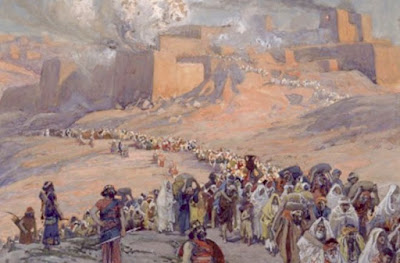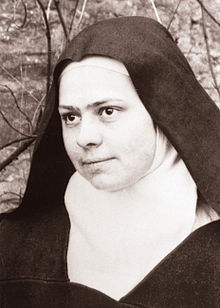The Bible has many stories of roads and highways. This is an occasional series of meditations based on those scriptures.
The Road to Exile
2 Kings 23:21-25:30, Psalm 137

I’m thinking about the biblical exile—-thinking about the people of God as refugees forced out of the land and into Babylon, following the destruction of Jerusalem. Here is a map(1) of the way the people traveled. Among the biblical accounts of roads and travel, this is a particularly tragic one.
By the rivers of Babylon—
there we sat down and there we wept
when we remembered Zion.
On the willows there
we hung up our harps.
For there our captors
asked us for songs,
and our tormentors asked for mirth, saying,
‘Sing us one of the songs of Zion!’
How could we sing the Lord’s song
in a foreign land? (Psalm 137:1-4)
If you’re familiar with biblical history, you know that the exile is a milestone of a very long story of God’s promise of land to his people, extending about 1500 years from Genesis 12 till the end of 2 Kings. It was the end of the Davidic monarchy (conventionally conceived) that had lasted about four hundred years, and it was a second experience of wilderness for God’s people, perhaps more profound than the forty years of Moses’ leadership. God’s punishment for the people’s covenant-breaking, which is how the exile was theologically understood, is the subject of many of the prophets—and so a great deal of the biblical text is in one way or another related to the exile.
 |
James Tissot, "The Flight of the Prisoners",
Jewish Museum, New York |
You can read the account of the disaster itself in 2 Kings 23:21-25:30 and Jeremiah chapter 52. Nebuchadnezzar and the Babylonians had already besieged Jerusalem in 605 BCE, resulting in tribute paid to the king by the king of Judah, Jehoiakim. But Jehoiakim eventually refused to pay tribute, leading to another siege, the death of Jehoiakim, and the exile of subsequent King Jeconiah and his court. Further deportations happened during the reign of Zedekiah. The dates of the deportation are often cited as about 598 and another in 586 (when Jerusalem was destroyed, along with Solomon’s Temple), and the last in about 582/581. Scholars debate the number of Jews who were deported, and how many stayed in the land, as well as the total number of deportations. Jeremiah and Ezekiel were the major prophets of this period; in fact, Ezekiel continued to minister to the people and communicated prophecies of hope.
The exile ended in about 538, when the Persian leader Cyrus allowed Jews to return to the land, and the Temple in Jerusalem was rebuilt in the 510s and after. The books of Ezra and Nehemiah cover this history, which concludes the period of biblical history.
As I said above, this is a profound event in the biblical history, but also far beyond. The exile shaped the subsequent history of Jews and Judaism. The Hebrew language was developed during this time. The Torah was likely compiled and edited during this time, becoming the sacred text for a people.(2) Many Jews did not return to the land, and so the Torah, along with synagogues and teacher-sages and mitzvot-oriented observance, became crucial aspects of Jewish religious and ethnic identity. Expectation of the return of the Davidic monarchy became important for many Jews. Such expectation was also crucial for the first century CE group of Jews who followed Jesus of Nazareth. Thus the experiences of exile, return, and expectation were also formative for the beginning of Christianity.
I write about this in more (informal) detail at
this site. Here, I want to say: when you hold your Bible in your hand and read it, the whole book is can be understood as a story of exile, the trauma of refugees, and the hope that keeps them going.
If we need any “inspiration” to contribute toward the well-being of refugee people in our own time, we could certainly start with the experience of Bible people as refugees and exiles who long for their home as reflected in the 137th Psalm. With news of Syria and Appello as on-going news stories, I refreshed my memory about the plights of refugees and exiles in the world. Turning to the UNHCR website (The UN Refugee Agency,
http://www.unrefugees.org/what-we-do/who-we-help/), I learned that there are currently 21.3 millions refugees in the world, over 50% of whom are children. Over 40.8 million are “internally displaced people” (IDPs), who have no home but have not crossed a border to safety. In 2014, 11 million were newly displaced. Colombia, Iraq, and South Sudan are countries with a high populations of IDPs. Ten million people are “stateless’; they’re minority people who have no citizenship status anywhere. About 3.2 million people are asylum seekers, seeking the right to receive legal protection and material assistance by being recognized as refugees.
Day by day I worry about my own small problems, in my own nice home, while these millions of people are in crisis.
You can find articles about specific refugee situations: for instance, I found this recent piece about IDPs in Serbia and Kosovo.
http://www.un.org/apps/news/story.asp?NewsID=54940#.V-p6FDKZM9c
Here is another article concerning Syrian refugees, about whom American politicians have misinformed the public in key ways.
http://www.factcheck.org/2015/11/facts-about-the-syrian-refugees/
Don’t be distracted from politically motivated misinformation about refugees: find out more for yourself, from nonpartisan and reputable sources.
Here is the site of the Catholic Relief Service, for instance, that contains several ideas for helping:
http://www.crs.org/media-center/syrian-refugee-crisis-7-things-you-can-do-help
Here is another site that I found, “welcoming refugees,”
http://www.welcomingrefugees.org/about-project
Do a Bible study:
http://www.ucc.org/justice_immigration_worship_biblical-references-to
http://www.relevantmagazine.com/god/what-bible-says-about-how-treat-refugees
Writing this post has inspired me, too, to contribute to some of these ministries and to be more informed.
Notes
1.
http://www.jewishvirtuallibrary.org/jsource/History/babyloniamap.html
2. The Old Testament scholar Walter Brueggemnan writes, “It may be that the final form of the Torah was not reached in the brief period of the Babylonian displacement, but rather in the subsequent Persian period during which there continued to be communities of passionate Jews far from Jerusalem. Either way, after the disruption of 587, under Babylonian or Persian aegis, Jews understood themselves to be exposed, vulnerable, not at risk without the visible supports of a stable homeland. For our purposes it does not matter greatly if the exile is ‘historical’ as given us in the Bible (as we are inclined to think), or if it is an ideological self-characterization. Either way, displaced people needed a place from which to validate a theologically informed, peculiar sense of identity and practice of life. The traditioning (sic) process that produced the Torah thus strikes us as a remarkable match for displacement, so that we may understand ‘the Torah of Moses’ as
a script for displaced community [my emphasis]. This connection greatly illuminates the fact, as noted above, that the ‘Torah of Moses’ concludes in Deuteronomy 34 with the death of Moses (thus the end of the normative period) and Israel posed to enter the land of promise but still landless. We may believe that this now normative tradition was powerfully and peculiarly germane to a community that understood itself as exiles, poised to reenter the land but still landless. Thus the Torah came to have durable validity for subsequent generations in the community as canon….” (
An Introduction to the Old Testament: The Canon and Christian Imagination, Westminster John Knox Press, 2003, p. 42).




















